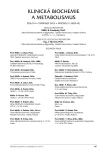Trace elements in critical states. Part 2: copper and selenium
Authors:
H. Brodská 1; A. Kazda 1; J. Valenta 2
Authors‘ workplace:
Ústav lékařské biochemie a laboratorní diagnostiky 1. LF UK a VFN Praha
1; Klinika anesteziologie, resuscitace a intenzivní medicíny 1. LF UK a VFN Praha
2
Published in:
Klin. Biochem. Metab., 21 (42), 2013, No. 4, p. 203-207
Overview
The second part of the communication on the issue of trace elements in critically ill patients is devoted to copper and selenium. After a short decrease in trauma, as well as in systemic inflammation, plasmatic level of copper increases. The copper is bound on ceruloplasmin, which is an acute phase reactant. Copper deficiency requiring substitution occurs in extensive burns, losses from the gastrointestinal tract or in negative balance during haemodialysis. Copper is necessary for the utilization of iron in the formation of haemoglobin and transferrin and therefore the insufficient level results to hypochromic anaemia. The authors present the recommended doses for copper supplementation in the aforementioned losses. Selenium possesses a number of functions important for the surviving of critical illness, including protection from the organic peroxides, the conversion of thyroxine to active triiodothyronine, improvement in response to glucocorticoids, glycaemic control, inhibition of adhesion molecules and the effect on the function of T-lymphocytes. The level of selenium is reduced in systemic inflammation and it falls progressively depending on the severity of condition (e.g. sepsis). The article reports a number of clinical trials with different regimens of supplementation with high doses of selenium, administered for maximal period of two weeks. The mortality rate has dropped significantly so far in one large clinical trial only. Some other trial have reported positive results in some outcomes: SOFA score improvement in patients with multiple organ dysfunctions, elevation of previously low cholesterol, praealbumin and glutathione peroxidase levels, and reduction in C-reactive protein values. The optimal therapeutic doses are discussed in detail. The toxic effects of copper and selenium overdose, which can cause a critical condition per se, are mentioned.
Keywords:
copper, selenium, trauma, systemic inflammation, critical care.
Sources
1. Berger, M. M.., Shenkin, A., Revelly, J. P. Copper, selenium, zinc and thiamin balance during continuos venovenous hemodiafiltration in critically ill patients. Am. J. Clin. Nutr., 2004, 80, p. 410-416.
2. Schmidt, M. G., Attaway, H. H., Sharpe, P. A., et al. Sustained reduction od microbial burden on common hospital surfaces through introduction of copper. J. Clin. Microbiol., 2012, 50(7), p. 2217-2223.
3. Shenkin, A. Trace elements and vitamins in parenteral and enteral nutrition. In: Sobotka, L. (ed.). Basics in clinical nutrition, Praha: Galén, 2000, p. 62-71.
4. Shenkin, A. Micronutrients. Physiologic function and deficiency states of trace elements. In Sobotka, L. (ed.). Basics in clinical nutrition, Praha: Galén, 2011, p. 53-59. a 140-145.
5. Berger, M. M., Baines, M., Raffoul, W. et al. Trace element supplementation after major burns modulates antioxidant status and clinical course by way of increased tissue trace element concentrations. Am. J Clin. Nutr., 2007, 85, p.1293-1300.
6. Strachan, S. Trace elements. Curr. Anaesth. Crit. Care, 2010, 21, s.44-48.
7. Hardy,Y. G., Mendenez, A. M., Pharm, B. et al. Trace element supplementation in parenteral nutrition: Pharmacy, posology, and monitoring guidance. Nutrition, 2009, 25, p. 1073-1084.
8. Duntas, L. H. Selenium and inflammation: underlying antiinflammmatory mechanisms. Horm. Metab. Res., 2009, 41, p. 443-447.
9. Forceville, X., van Antwerpen, P. Selenocompounds and selenium: a biochemical approach to sepsis. In Vincent, J.-L. (ed), 2008 Yearbook of intensive care and emergency medicine. Berlin: Springer, 2008, p. 456-466.
10. Shenkin, A. Selenium in intravenous nutrition. Gastroenterology, 2009, 137, p. 61-69.
11. Valenta, J., Brodská, H., Drábek, T., et al. Selenium: an important trace element and therapeutic adjunct in criticall care. Trace Elem. Electrol., 2012, 29 (4), p. 246 -255.
12. Hardy, G., Hardy, I., Manzanares, W. Selenium suplementation in critically ill. Nutr. Clin. Pract., 2012, 27 (1), p. 21-33.
13. Manzanares, W., Biestro, A., Galusso, F., et al. Serum selenium and glutathione peroxidase-3-activity: biomarkers of systemic inflammation in the critically ill. Intensive Care Med., 2009, 35, p. 882-889.
14. Angstwurm, M. W., Engelmann, L., Zimmermann,T. Selenium in intensive care (SIC) study: results in patients with severe SIRS, sepsis and septic shock. Crit Care Med, 2007, 35, 1, p. 1-9.
15. Mishra, V., Baines, M., Perry, S. E., et al. Effect of selenium supplementation on biochemical markers and outcome in crittically ill patients. Clin. Nutr., 2007, 26, p. 41-50.
16. Manzanares, W., Biestro, A., Galusso, F., et al. High dose selenium for critically ill patients with systemic inflamation: pharmacokinetics and pharmacodynamics of selenious acid. Nutrition, 2010, 26, p. 634-640.
17. Manzanares, W. E., Biestro, A., Torre, M. H. High dose selenium reduces ventilator associated pneumonia and illnes severity in critically ill aptients. Intens. Care Med., 2011, 12, p. 273-280.
18. Stoppe, Ch., Spillner, J., Rossaint, R. et al. Selenium blood concentrations in patients undergoing elective cardiac surgery and receiving perioperative sodium selenite. Nutrition, 2013, 29, p. 158-165.
19. Kazda, A., Brodská, H., Valenta, J. Problematika a sledování suplementace zinku a selenu v intenzivní péči. Klin. bioch. metab., 2004, 3, p.184-189.
20. Brodská, H., Kazda, A., Valenta, J., et al. High dose of selenium in critically ill. Clin Nutrition, Suppl., 2007, p. 20-21.
21. Valenta, J., Brodská, H., Drábek, T., et al. High-dose selenium substitution in sepsis: a prospective, randomized clinical trial. Intensive Care Med., 2011, 37, p. 808-815.
Labels
Clinical biochemistry Nuclear medicine Nutritive therapistArticle was published in
Clinical Biochemistry and Metabolism

2013 Issue 4
Most read in this issue
- Haemolysis influence on the determination of total and direct bilirubin
- Cerebrospinal fluid analysis in the diagnosis of subarachnoid hemorrhage
- Trace elements in critical states. Part 1: zinc and iron
- Trace elements in critical states. Part 2: copper and selenium
